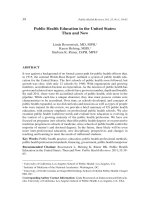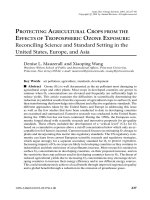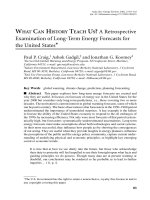2000 CDC Growth Charts for the United States: Methods and Development - part 1 potx
Bạn đang xem bản rút gọn của tài liệu. Xem và tải ngay bản đầy đủ của tài liệu tại đây (2.51 MB, 12 trang )
Series 11, Number 246 May 2002
2000 CDC Gr owth Charts for
the United States: Methods
and De velopment
Copyright information
All material appearing in this report is in the public domain and may be
reproduced or copied without permission; citation as to source, however, is
appreciated.
Suggested Citation
Kuczmarski RJ, Ogden CL, Guo SS, et al. 2000 CDC growth charts for the
United States: Methods and development. National Center for Health Statistics.
Vital Health Stat 11(246). 2002
Library of Congress Cataloging-in-Publication Data
2000 CDC growth charts for the United States: methods and development.
p. cm. — (DHHS publication ; no. (PHS) 2002-1696) (Vital and health
statistics. Series 11, Data from the National Health Survey ; no. 246)
‘‘May, 2002.’’
ISBN 0-8406-0575-7
1. Children—Anthropometry—United States—Statistics. 2. Children—
United States—Growth—Statistics. 3. United States—Statistics, Vital.
I. Series. II. Series: Vital and health statistics. Series 11, Data from the
National Health Survey ; no. 246
GN63 .A225 2001
305.23'0973'021—dc21 2001051405
For sale by the U.S. Government Printing Office
Superintendent of Documents
Mail Stop: SSOP
Washington, DC 20402-9328
Printed on acid-free paper.
Series 11, Number 246
2000 CDC Gr owth Charts for
the United States: Methods
and De velopment
Data From the National Health
Examination Surveys and the National
Health and Nutrition Examination
Surveys
DEPARTMENT OF HEALTH AND HUMAN SERVICES
Centers for Disease Control and Prevention
National Center for Health Statistics
Hyattsville, Maryland
May 2002
DHHS Publication No. (PHS) 2002-1696
National Center for Health Statistics
Edward J. Sondik, Ph.D., Director
Jack R. Anderson, Deputy Director
Jack R. Anderson, Acting Associate Director for
International Statistics
Jennifer H. Madans, Ph.D., Associate Director for Science
Lawrence H. Cox, Ph.D., Associate Director for Research
and Methodology
Jennifer H. Madans, Ph.D., Acting Associate Director for
Analysis, Epidemiology, and Health Promotion
Edward L. Hunter, Associate Director for Planning, Budget,
and Legislation
Jennifer H. Madans, Ph.D., Acting Associate Director for
Vital and Health Statistics Systems
Douglas L. Zinn, Acting Associate Director for
Management
Charles J. Rothwell, Associate Director for Information
Technology and Services
Division of Health Examination Statistics
Clifford L. Johnson, M.S.P.H., Director
Rosemarie Hirsch, M.D., M.P.H., Chief Analysis Branch
Carolyn Petty-Martin, Acting Chief Operations Branch
Vicki L. Burt, Sc.M., R.N., Chief Planning Branch
Lewis Berman, M.S., Chief Information Management Branch
Acknowledgments
W
e wish to gratefully
acknowledge the contributions
of many individuals who had
various roles in the growth chart
revision process. These contributions
include statistical and computer
programming expertise, data and
summary statistics, graphical support,
and knowledge and experience in the
areas of pediatric growth and growth
charts. We also wish to thank Thelma
Sanders and Zung Le for their editorial
support. In addition to acknowledging
the contributions of all individuals
identified in
appendix I of this report,
the following persons are also
recognized, with their affiliations at the
time of their contribution:
Phil Batty
Center for Health Information
Management and Epidemiology
State of Missouri Department of Health
Jefferson City, MO
Fred Buhr
Center for Health Statistics
State of Wisconsin Department of
Health and Family Services
Madison, WI
Margaret Carroll
National Center for Health Statistics
Centers for Disease Control and
Prevention
Hyattsville, MD
John Chang
Computer Information Systems and
Support Services
Nova Research Company
Bethesda, MD
Chris Cronk
Center for Health Statistics
State of Wisconsin Department of
Health and Family Services
Madison, WI
William Davis
Klemm Analysis Group, Inc.
Washington, DC
Catherine Duran
National Center for Health Statistics
Centers for Disease Control and
Prevention
Hyattsville, MD
Odell Eldridge
Computer Information Systems and
Support Services
Nova Research Company
Bethesda, MD
Stephen Sloan
National Center for Health Statistics
Centers for Disease Control and
Prevention
Hyattsville, MD
Christine Zeller
Department of Community Health
Wright State University
Yellow Springs, OH
iii
Contents
Acknowledgments iii
Abstract 1
Introduction 1
Historical Background 1
Concerns Surrounding the 1977 Charts 2
The Revision 3
Methods 3
Data Sources 3
Data Exclusions 5
Statistical Curve Smoothing Procedures 5
Results 10
Observed and Smoothed Percentiles 10
Evaluation of the Revised Growth Curves 10
Differences Between the 1977 NCHS and the 2000 CDC Growth Curves 11
Discussion 11
Revision Process 11
Growth Chart Workshops 12
Major Features of the 2000 CDC Growth Charts for the United States 12
Using the Revised Growth Charts 12
Specialized Charts 13
General Growth Chart Principles 14
Conclusions 15
References 16
Appendix I. Description of Growth Chart Workshops 187
Workshop 1 187
Workshop 2 188
Workshop 3 189
Workshop 4 189
Appendix Table
I. Participants in the NCHS growth chart workshops 187
Figures
1. Individual growth chart 3rd, 5th, 10th, 25th, 50th, 75th, 90th, 95th, 97th percentiles, birth to 36 months:
Boys weight-for-age 19
2. Individual growth chart 3rd, 5th, 10th, 25th, 50th, 75th, 90th, 95th, 97th percentiles, birth to 36 months:
Girls weight-for-age 20
3. Individual growth chart 3rd, 5th, 10th, 25th, 50th, 75th, 90th, 95th, 97th percentiles, birth to 36 months:
Boys length-for-age 21
4. Individual growth chart 3rd, 5th, 10th, 25th, 50th, 75th, 90th, 95th, 97th percentiles, birth to 36 months:
Girls length-for-age 22
v
5. Individual growth chart 3rd, 5th, 10th, 25th, 50th, 75th, 90th, 95th, 97th percentiles, birth to 36 months:
Boys weight-for-length 23
6. Individual growth chart 3rd, 5th, 10th, 25th, 50th, 75th, 90th, 95th, 97th percentiles, birth to 36 months:
Girls weight-for-length 24
7. Individual growth chart 3rd, 5th, 10th, 25th, 50th, 75th, 90th, 95th, 97th percentiles, birth to 36 months:
Boys head circumference-for-age 25
8. Individual growth chart 3rd, 5th, 10th, 25th, 50th, 75th, 90th, 95th, 97th percentiles, birth to 36 months:
Girls head circumference-for-age 26
9. Individual growth chart 3rd, 5th, 10th, 25th, 50th, 75th, 90th, 95th, 97th percentiles, 2 to 20 years:
Boys weight-for-age 27
10. Individual growth chart 3rd, 5th, 10th, 25th, 50th, 75th, 90th, 95th, 97th percentiles, 2 to 20 years:
Girls weight-for-age 28
11. Individual growth chart 3rd, 5th, 10th, 25th, 50th, 75th, 90th, 95th, 97th percentiles, 2 to 20 years:
Boys stature-for-age 29
12. Individual growth chart 3rd, 5th, 10th, 25th, 50th, 75th, 90th, 95th, 97th percentiles, 2 to 20 years:
Girls stature-for-age 30
13. Individual growth chart 3rd, 5th, 10th, 25th, 50th, 75th, 85th, 90th, 95th, 97th percentiles, 2 to 20 years:
Boys body mass index-for-age 31
14. Individual growth chart 3rd, 5th, 10th, 25th, 50th, 75th, 85th, 90th, 95th, 97th percentiles, 2 to 20 years:
Girls body mass index-for-age 32
15. Individual growth chart 3rd, 5th, 10th, 25th, 50th, 75th, 85th, 90th, 95th, 97th percentiles: Boys weight-for-stature . . . 33
16. Individual growth chart 3rd, 5th, 10th, 25th, 50th, 75th, 85th, 90th, 95th, 97th percentiles: Girls weight-for-stature . . . 34
17. Clinical growth chart 5th, 10th, 25th, 50th, 75th, 90th, 95th percentiles, birth to 36 months: Boys length-for-age
and weight-for-age percentiles 35
18. Clinical growth chart 5th, 10th, 25th, 50th, 75th, 90th, 95th percentiles, birth to 36 months: Girls length-for-age
and weight-for-age percentiles 36
19. Clinical growth chart 5th, 10th, 25th, 50th, 75th, 90th, 95th percentiles, birth to 36 months: Boys head
circumference-for-age and weight-for-length 37
20. Clinical growth chart 5th, 10th, 25th, 50th, 75th, 90th, 95th percentiles, birth to 36 months: Girls head
circumference-for-age and weight-for-length 38
21. Clinical growth chart 5th, 10th, 25th, 50th, 75th, 90th, 95th percentiles, 2 to 20 years: Boys stature-for-age and
weight-for-age 39
22. Clinical growth chart 5th, 10th, 25th, 50th, 75th, 90th, 95th percentiles, 2 to 20 years: Girls stature-for-age and
weight-for-age 40
23. Clinical growth chart 5th, 10th, 25th, 50th, 75th, 85th, 90th, 95th percentiles, 2 to 20 years: Boys body mass
index-for-age 41
24. Clinical growth chart 5th, 10th, 25th, 50th, 75th, 85th, 90th, 95th percentiles, 2 to 20 years: Girls body mass
index-for-age 42
25. Clinical growth chart 5th, 10th, 25th, 50th, 75th, 85th, 90th, 95th percentiles: Boys weight-for-stature 43
26. Clinical growth chart 5th, 10th, 25th, 50th, 75th, 85th, 90th, 95th percentiles: Girls weight-for-stature 44
27. Smoothed percentile curves, 22–39 months: Boys length-for-age and stature-for-age 45
28. Smoothed percentile curves, 22–39 months: Girls length-for-age and stature-for-age 46
29. Smoothed percentile curves, 75–106 cm: Boys weight-for-length and weight-for-stature 47
30. Smoothed percentile curves, 75–106 cm: Girls weight-for-length and weight-for-stature 48
31. Comparison of smoothed 3rd, 10th, 50th, 90th, 97th percentile curves to empirical data points, birth to 36 months:
Boys weight-for-age 49
32. Comparison of smoothed 5th, 25th, 50th, 75th, 95th percentile curves to empirical data points, birth to 36 months:
Boys weight-for-age 50
33. Comparison of smoothed 3rd, 10th, 50th, 90th, 97th percentile curves to empirical data points, birth to 36 months:
Girls weight-for-age 51
34. Comparison of smoothed 5th, 25th, 50th, 75th, 95th percentile curves to empirical data points, birth to 36 months:
Girls weight-for-age 52
35. Comparison of smoothed 3rd, 10th, 50th, 90th, 97th percentile curves to empirical data points, birth to 36 months:
Boys recumbent length-for-age 53
36. Comparison of smoothed 5th, 25th, 50th, 75th, 95th percentile curves to empirical data points, birth to 36 months:
Boys recumbent length-for-age 54
37. Comparison of smoothed 3rd, 10th, 50th, 90th, 97th percentile curves to empirical data points, birth to 36 months:
Girls recumbent length-for-age 55
vi
38. Comparison of smoothed 5th, 25th, 50th, 75th, 95th percentile curves to empirical data points, birth to 36 months:
Girls recumbent length-for-age 56
39. Comparison of smoothed 3rd, 10th, 50th, 90th, 97th percentile curves to empirical data points, 46–102 cm:
Boys weight-for-length 57
40. Comparison of smoothed 5th, 25th, 50th, 75th, 95th percentile curves to empirical data points, 46–102 cm:
Boys weight-for-length 58
41. Comparison of smoothed 3rd, 10th, 50th, 90th, 97th percentile curves to empirical data points, 46–102 cm:
Girls weight-for-length 59
42. Comparison of smoothed 5th, 25th, 50th, 75th, 95th percentile curves to empirical data points, 46–102 cm:
Girls weight-for-length 60
43. Comparison of smoothed 3rd, 10th, 50th, 90th, 97th percentile curves to empirical data points, birth to 36 months:
Boys head circumference-for-age 61
44. Comparison of smoothed 5th, 25th, 50th, 75th, 95th percentile curves to empirical data points, birth to 36 months:
Boys head circumference-for-age 62
45. Comparison of smoothed 3rd, 10th, 50th, 90th, 97th percentile curves to empirical data points, birth to 36 months:
Girls head circumference-for-age 63
46. Comparison of smoothed 5th, 25th, 50th, 75th, 95th percentile curves to empirical data points, birth to 36 months:
Girls head circumference-for-age 64
47. Comparison of smoothed 3rd, 10th, 50th, 90th, 97th percentile curves to empirical data points, 78–120 cm:
Boys weight-for-stature 65
48. Comparison of smoothed 5th, 25th, 50th, 75th, 95th percentile curves to empirical data points, 78–120 cm:
Boys weight-for-stature 66
49. Comparison of smoothed 3rd, 10th, 50th, 90th, 97th percentile curves to empirical data points, 78–120 cm:
Girls weight-for-stature 67
50. Comparison of smoothed 5th, 25th, 50th, 75th, 95th percentile curves to empirical data points, 78–120 cm:
Girls weight-for-stature 68
51. Comparison of smoothed 3rd, 10th, 50th, 90th, 97th percentile curves to empirical data points, 24–237 months:
Boys weight-for-age 69
52. Comparison of smoothed 5th, 25th, 50th, 75th, 95th percentile curves to empirical data points, 24–237 months:
Boys weight-for-age 70
53. Comparison of smoothed 3rd, 10th, 50th, 90th, 97th percentile curves to empirical data points, 24–237 months:
Girls weight-for-age 71
54. Comparison of smoothed 5th, 25th, 50th, 75th, 95th percentile curves to empirical data points, 24–237 months:
Girls weight-for-age 72
55. Comparison of smoothed 3rd, 10th, 50th, 90th, 97th percentile curves to empirical data points, 24–237 months:
Boys stature-for-age 73
56. Comparison of smoothed 5th, 25th, 50th, 75th, 95th percentile curves to empirical data points, 24–237 months:
Boys stature-for-age 74
57. Comparison of smoothed 3rd, 10th, 50th, 90th, 97th percentile curves to empirical data points, 24–237 months:
Girls stature-for-age 75
58. Comparison of smoothed 5th, 25th, 50th, 75th, 95th percentile curves to empirical data points, 24–237 months:
Girls stature-for-age 76
59. Comparison of smoothed 3rd, 10th, 50th, 90th, 97th percentile curves to empirical data points, 24–237 months:
Boys body mass index-for-age 77
60. Comparison of smoothed 5th, 25th, 50th, 75th, 85th, 95th percentile curves to empirical data points,
24–237 months: Boys body mass index-for-age 78
61. Comparison of smoothed 3rd, 10th, 50th, 90th, 97th percentile curves to empirical data points, 24–237 months:
Girls body mass index-for-age 79
62. Comparison of smoothed 5th, 25th, 50th, 75th, 85th, 95th percentile curves to empirical data points, 24–237 months:
Girls body mass index-for-age 80
63. Percent of empirical data below smoothed 3rd, 10th, 50th, 90th, 97th percentile curves, birth to 33 months:
Boys weight-for-age 81
64. Percent of empirical data below smoothed 5th, 25th, 50th, 75th, 95th percentile curves, birth to 33 months:
Boys weight-for-age 82
65. Percent of empirical data below smoothed 3rd, 10th, 50th, 90th, 97th percentile curves, birth to 33 months:
Girls weight-for-age 83
66. Percent of empirical data below smoothed 5th, 25th, 50th, 75th, 95th percentile curves, birth to 33 months:
Girls weight-for-age 84
vii
67. Percent of empirical data below smoothed 3rd, 10th, 50th, 90th, 97th percentile curves, birth to 33 months:
Boys length-for-age 85
68. Percent of empirical data below smoothed 5th, 25th, 50th, 75th, 95th percentile curves, birth to 33 months:
Boys length-for-age 86
69. Percent of empirical data below smoothed 3rd, 10th, 50th, 90th, 97th percentile curves, birth to 33 months:
Girls length-for-age 87
70. Percent of empirical data below smoothed 5th, 25th, 50th, 75th, 95th percentile curves, birth to 33 months:
Girls length-for-age 88
71. Percent of empirical data below smoothed 3rd, 10th, 50th, 90th, 97th percentile curves, 46–103 cm: Boys weight-
for-length 89
72. Percent of empirical data below smoothed 5th, 25th, 50th, 75th, 95th percentile curves, 46–103 cm: Boys weight-
for-length 90
73. Percent of empirical data below smoothed 3rd, 10th, 50th, 90th, 97th percentile curves, 46–103 cm: Girls weight-
for-length 91
74. Percent of empirical data below smoothed 5th, 25th, 50th, 75th, 95th percentile curves, 46–103 cm: Girls weight-
for-length 92
75. Percent of empirical data below smoothed 3rd, 10th, 50th, 90th, 97th percentile curves, birth to 33 months: Boys
head circumference-for-age 93
76. Percent of empirical data below smoothed 5th, 25th, 50th, 75th, 95th percentile curves, birth to 33 months:
Boys head circumference-for-age 94
77. Percent of empirical data below smoothed 3rd, 10th, 50th, 90th, 97th percentile curves, birth to 33 months:
Girls head circumference-for-age 95
78. Percent of empirical data below smoothed 5th, 25th, 50th, 75th, 95th percentile curves, birth to 33 months:
Girls head circumference-for-age 96
79. Percent of empirical data below smoothed 3rd, 10th, 50th, 90th, 97th percentile curves, 84–122 cm: Boys weight-
for-stature 97
80. Percent of empirical data below smoothed 5th, 25th, 50th, 75th, 95th percentile curves, 84–122 cm: Boys weight-
for-stature 98
81. Percent of empirical data below smoothed 3rd, 10th, 50th, 90th, 97th percentile curves, 84–122 cm: Girls weight-
for-stature 99
82. Percent of empirical data below smoothed 5th, 25th, 50th, 75th, 95th percentile curves, 84–122 cm: Girls weight-
for-stature 100
83. Percent of empirical data below smoothed 3rd, 10th, 50th, 90th, 97th percentile curves, 27–237 months:
Boys weight-for-age 101
84. Percent of empirical data below smoothed 5th, 25th, 50th, 75th, 95th percentile curves, 27–237 months:
Boys weight-for-age 102
85. Percent of empirical data below smoothed 3rd, 10th, 50th, 90th, 97th percentile curves, 27–237 months:
Girls weight-for-age 103
86. Percent of empirical data below smoothed 5th, 25th, 50th, 75th, 95th percentile curves, 27–237 months:
Girls weight-for-age 104
87. Percent of empirical data below smoothed 3rd, 10th, 50th, 90th, 97th percentile curves, 27–237 months:
Boys stature-for-age 105
88. Percent of empirical data below smoothed 5th, 25th, 50th, 75th, 95th percentile curves, 27–237 months:
Boys stature-for-age 106
89. Percent of empirical data below smoothed 3rd, 10th, 50th, 90th, 97th percentile curves, 27–237 months:
Girls stature-for-age 107
90. Percent of empirical data below smoothed 5th, 25th, 50th, 75th, 95th percentile curves, 27–237 months:
Girls stature-for-age 108
91. Percent of empirical data below smoothed 3rd, 10th, 50th, 90th, 97th percentile curves, 27–237 months:
Boys body mass index-for-age 109
92. Percent of empirical data below smoothed 5th, 25th, 50th, 75th, 85th, 95th percentile curves, 27–237 months:
Boys body mass index-for-age 110
93. Percent of empirical data below smoothed 3rd, 10th, 50th, 90th, 97th percentile curves, 27–237 months:
Girls body mass index-for-age 111
94. Percent of empirical data below smoothed 5th, 25th, 50th, 75th, 85th, 95th percentile curves, 27–237 months:
Girls body mass index-for-age 112
95. Comparison of CDC 2000 smoothed 3rd, 5th, 10th, 25th, 50th, 75th, 90th, 95th, 97th percentiles with NCHS 1977
smoothed 5th, 10th, 25th, 50th, 75th, 90th, 95th percentile curves, birth to 36 months: Boys weight-for-age 113
viii
96. Comparison of CDC 2000 smoothed 3rd, 5th, 10th, 25th, 50th, 75th, 90th, 95th, 97th percentiles with NCHS 1977
smoothed 5th, 10th, 25th, 50th, 75th, 90th, 95th percentile curves, birth to 36 months: Girls weight-for-age 114
97. Comparison of CDC 2000 smoothed 3rd, 5th, 10th, 25th, 50th, 75th, 90th, 95th, 97th percentiles with
NCHS 1977 smoothed 5th, 10th, 25th, 50th, 75th, 90th, 95th percentile curves, birth to 36 months:
Boys recumbent length-for-age 115
98. Comparison of CDC 2000 smoothed 3rd, 5th, 10th, 25th, 50th, 75th, 90th, 95th, 97th percentiles with
NCHS 1977 smoothed 5th, 10th, 25th, 50th, 75th, 90th, 95th percentile curves, birth to 36 months:
Girls recumbent length-for-age 116
99. Comparison of CDC 2000 smoothed 3rd, 5th, 10th, 25th, 50th, 75th, 90th, 95th, 97th percentiles with NCHS 1977
smoothed 5th, 10th, 25th, 50th, 75th, 90th, 95th percentile curves, 49–94 cm: Boys weight-for-length 117
100. Comparison of CDC 2000 smoothed 3rd, 5th, 10th, 25th, 50th, 75th, 90th, 95th, 97th percentiles with NCHS 1977
smoothed 5th, 10th, 25th, 50th, 75th, 90th, 95th percentile curves, 49–94 cm: Girls weight-for-length 118
101. Comparison of CDC 2000 smoothed 3rd, 5th, 10th, 25th, 50th, 75th, 90th, 95th, 97th percentiles with
NCHS 1977 smoothed 5th, 10th, 25th, 50th, 75th, 90th, 95th percentile curves, birth to 36 months:
Boys head circumference-for-age 119
102. Comparison of CDC 2000 smoothed 3rd, 5th, 10th, 25th, 50th, 75th, 90th, 95th, 97th percentiles with
NCHS 1977 smoothed 5th, 10th, 25th, 50th, 75th, 90th, 95th percentile curves, birth to 36 months:
Girls head circumference-for-age 120
103. Comparison of CDC 2000 smoothed 3rd, 5th, 10th, 25th, 50th, 75th, 90th, 95th, 97th percentiles with NCHS 1977
smoothed 5th, 10th, 25th, 50th, 75th, 90th, 95th percentile curves, 91–120 cm: Boys weight-for-stature 121
104. Comparison of CDC 2000 smoothed 3rd, 5th, 10th, 25th, 50th, 75th, 90th, 95th, 97th percentiles with NCHS 1977
smoothed 5th, 10th, 25th, 50th, 75th, 90th, 95th percentile curves, 91–120 cm: Girls weight-for-stature 122
105. Comparison of revised CDC 2000 smoothed 3rd, 5th, 10th, 25th, 50th, 75th, 90th, 95th, 97th percentiles with
NCHS 1977 smoothed 5th, 10th, 25th, 50th, 75th, 90th, 95th percentile curves, 24–213 months:
Boys weight-for-age 123
106. Comparison of CDC 2000 smoothed 3rd, 5th, 10th, 25th, 50th, 75th, 90th, 95th, 97th percentiles with NCHS 1977
smoothed 5th, 10th, 25th, 50th, 75th, 90th, 95th percentile curves, 24–213 months: Girls weight-for-age 124
107. Comparison of CDC 2000 smoothed 3rd, 5th, 10th, 25th, 50th, 75th, 90th, 95th, 97th percentiles with NCHS 1977
smoothed 5th, 10th, 25th, 50th, 75th, 90th, 95th percentile curves, 24–213 months: Boys stature-for-age 125
108. Comparison of CDC 2000 smoothed 3rd, 5th, 10th, 25th, 50th, 75th, 90th, 95th, 97th percentiles with NCHS 1977
smoothed 5th, 10th, 25th, 50th, 75th, 90th, 95th percentile curves, 24–213 months: Girls stature-for-age 126
Text Tables
A. Charts included in the 1977 NCHS Growth Charts and the 2000 CDC Growth Charts 2
B. Source of data for each growth chart 3
C. Primary and supplemental data sources 4
D. Summary of curve smoothing procedures 6
Detailed Tables
1. Unweighted sample sizes for weight-for-age chart by sex, age, and data source: Births to 36 months 127
2. Unweighted sample sizes for recumbent length-for-age chart by sex, age, and data source: Birth to 36 months 128
3. Unweighted sample sizes for weight-for-recumbent length chart by sex, length interval, and data source:
Birth to 36 months 129
4. Unweighted sample sizes for head circumference-for-age chart by sex, age, and data source: Birth to 36 months 130
5. Unweighted sample sizes for weight-for-stature chart by sex, stature interval, and data source: 77 to 121 cm 131
6. Unweighted sample sizes for weight-for-age chart by sex, age, and data source: 2 to 20 years 132
7. Unweighted sample sizes for stature-for-age chart by sex, age, and data source: 2 to 20 years 134
8. Unweighted sample sizes for body mass index (BMI)-for-age chart by sex, age, and data source: 2 to 20 years 136
9. Observed mean, standard deviation, and selected percentiles for weight (in kilograms) by sex and age:
Birth to 36 months 138
10. Observed mean, standard deviation, and selected percentiles for recumbent length (in centimeters) by sex and age:
Birth to 36 months 139
11. Observed mean, standard deviation, and selected percentiles for weight (in kilograms) by sex and recumbent length:
Birth to 36 months 140
12. Observed mean, standard deviation, and selected percentiles for head circumference (in centimeters) by sex and age:
Birth to 36 months 141
ix
13. Observed mean, standard deviation, and selected percentiles for weight (in kilograms) by sex and stature:
77 to 121 cm 142
14. Observed mean, standard deviation, and selected percentiles for weight (in kilograms) by sex and age:
2 to 20 years 143
15. Observed mean, standard deviation, and selected percentiles for stature (in centimeters) by sex and age:
2 to 20 years 145
16. Observed mean, standard deviation, and selected percentiles for body mass index (kilograms/meter
2
)by
sex and age: 2 to 20 years 147
17. L, M, and S parameters and selected smoothed percentiles for weight (in kilograms) by sex and age:
Birth to 36 months 149
18. L, M, and S parameters and selected smoothed percentiles for recumbent length (in centimeters) by sex and age:
Birth to 36 months 151
19. L, M, and S parameters and selected smoothed percentiles for weight (in kilograms) by sex and recumbent length
(in centimeters): Birth to 36 months 153
20. L, M, and S parameters and selected smoothed percentiles for head circumference (in centimeters) by sex and age:
Birth to 36 months 156
21. L, M, and S parameters and selected smoothed percentiles for weight (in kilograms) by sex and stature (in centimeters):
77 to 121 cm 158
22. L, M, and S parameters and selected smoothed percentiles for weight (in kilograms) by sex and age: 2 to 20 years . . 160
23. L, M, and S parameters and selected smoothed percentiles for stature (in centimeters) by sex and age: 2 to 20 years . 169
24. L, M, and S parameters and selected smoothed percentiles for body mass index (BMI, kilograms/meter
2
)bysex
and age: 2 to 20 years 178
x
Series 11, No. 246 [ Page 7
parametric form with estimated
parameters specific for each selected
major percentile.
The parameters of the linear
regressions were estimated using the
SAS procedure REG, and the parameters
in the nonlinear regression were
estimated using the SAS procedure
NLIN (39). The fit of the models was
evaluated using root mean square error
(RMSE), R
2
, and CV (40).
The Transformation Stage
In order to estimate any percentile
and allow calculation of standard
deviation units and z-scores, a modified
LMS statistical procedure was applied to
the smoothed percentile curves. The
LMS method does not change the
distribution of percentile curves in a
growth chart; rather it provides a way to
estimate percentiles in a continuous
manner.
The distribution of some
anthropometric data used in the growth
charts are skewed. To remove skewness,
a power transformation can be used to
stretch one tail of the distribution while
the other tail is shrunk. A Box-Cox
transformation can make the distribution
nearly normal (41). The assumption is
that, after the appropriate power
transformation, the data are closely
approximated by a normal
distribution (42). The transformation
does not adjust for kurtosis, which is a
less important contributor to
nonnormality than skewness (43).
In the LMS technique, three
parameters are estimated: the median
(M), the generalized coefficient of
variation (S), and the power in the
Box-Cox transformation (L). The L
reflects the degree of skewness. The
LMS transformation equation is:
X = M (1 + LSZ)
1/L
L ≠ 0
or
X = M exp(SZ) L =0
where X is the physical measurement
and Z is the z-score that corresponds to
the percentile.
The key task of the transformation
was to estimate parameters L, M, and S.
With estimates of L, M, and S, values of
X are connected to the values of Z
through the above equation. The
percentile is obtained from a normal
distribution table where the z-score
corresponds to the percentile of interest.
For example, a z-score of 0.2019
corresponds to the 58th percentile. In
the case of growth charts, with the L, M,
and S parameters, it is possible to
evaluate any single measure in a
population as an exact z-score or
percentile.
To generate age-specific estimates
of L, M, and S, Cole (42,44) has
recommended applying a penalized
likelihood estimation procedure to the
raw data. In this approach smoothed
curves of L, M, and S are generated
first, and then smoothed percentile
curves, or an individual standardized
score, can be obtained from the values
of L, M, and S.
In contrast to the original LMS
procedure, a modified LMS estimation
procedure was created and used to
generate the 2000 CDC Growth Charts.
In the modified LMS approach,
empirical percentile curves were initially
smoothed and parametric models were
generated, as described above. Then, at
each age or length/stature interval, a
group of 9 equations (10 for BMI
charts) was generated by specifying the
LMS transformation equations for the
previously smoothed major percentiles.
A simultaneous solution for the three
parameters of L, M, and S from the
group of specified equations was
generated using the SAS procedure
NLIN (39). By minimizing the sum of
squared errors, the set of L, M, and S
parameters was obtained as the best
solution to a system of equations rather
than as likelihood-based estimates from
empirical data. This approach is similar
to the method used by Cole to estimate
LMS parameters from published
percentile curves (45–47).
This modified LMS procedure
produced final curves that are extremely
close to the smoothed percentile curves
obtained from the first stage of
smoothing. The net result is that the
close fit of the smoothed curves from
the first stage of smoothing to the
empirical data is retained. In addition,
the modified LMS method allows
z-scores to be obtained in a continuous
manner. The LMS values were
calculated by solving equations that
used the values for percentiles ranging
from the 3rd to the 97th. Percentiles less
than the 3rd or greater than the 97th are
beyond the range of the data from
which the LMS parameters were
calculated. As in any statistical
procedure, extrapolation beyond the
range of the data should be done with
caution.
The final set of percentile curves
for the CDC growth charts presented in
this report was produced using this
modified LMS estimation procedure. In
the transformation stage, percentiles
were developed at 1-month or
1-centimeter intervals in the infant and
child charts. Estimates of L, M, and S
parameters in these intervals were
calculated to provide the necessary tools
for determining additional percentiles.
Generally, 1-month or 1-centimeter
intervals will be adequate for estimation
or evaluation. To obtain percentiles at
finer intervals, the L, M, and S values
could be interpolated.
Detailed Procedures by Chart
Weight-for-Age
Combining infant and child/adolescent
weight-for-age—After the infant
weight-for-age and child/adolescent
weight-for-age curves were smoothed
using a 3-parameter linear model and
LWR, the results were combined and
refit from birth to age 20 years using a
single regression model for each sex.
The smoothed weight-for-age curves for
infants and for older children were
combined to obtain a seamless transition
between the curves. Ultimately the
combined weight-for-age curve was
separated into infant and child/
adolescent curves to facilitate use in
clinical settings.
In order to combine the infant and
child/adolescent weight-for-age curves,
weighted averages of overlapping
empirical percentiles from infant and
child charts at 2.25 years (24.0–29.9
months) and 2.75 years (30.0–35.9
months) were calculated using the
combined infant and child/adolescent
data. The empirical percentiles were not
identical at ages 24–36.9 months
because VLBW infants (<1,500 grams)
were excluded from the infant









